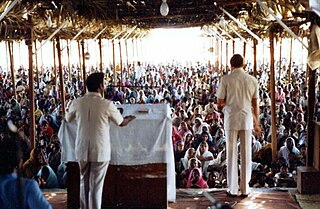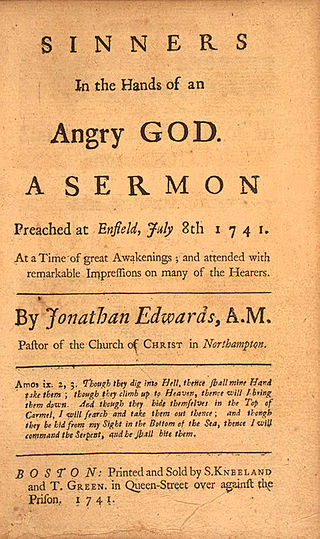Methodism, also called the Methodist movement, is a group of historically related denominations of Protestant Christianity whose origins, doctrine and practice derive from the life and teachings of John Wesley. George Whitefield and John's brother Charles Wesley were also significant early leaders in the movement. They were named Methodists for "the methodical way in which they carried out their Christian faith". Methodism originated as a revival movement within Anglicanism originating out of the Church of England in the 18th century and became a separate denomination after Wesley's death. The movement spread throughout the British Empire, the United States and beyond because of vigorous missionary work, and today has about 80 million adherents worldwide.

John Wesley was an English cleric, theologian, and evangelist who was a leader of a revival movement within the Church of England known as Methodism. The societies he founded became the dominant form of the independent Methodist movement that continues to this day.
The Methodist Episcopal Church (MEC) was the oldest and largest Methodist denomination in the United States from its founding in 1784 until 1939. It was also the first religious denomination in the US to organize itself nationally. In 1939, the MEC reunited with two breakaway Methodist denominations to form the Methodist Church. In 1968, the Methodist Church merged with the Evangelical United Brethren Church to form the United Methodist Church.
The Holiness movement is a Christian movement that emerged chiefly within 19th-century Methodism, and to a lesser extent influenced other traditions such as Quakerism, Anabaptism, and Restorationism. The movement is historically distinguished by its emphasis on the doctrine of a second work of grace, generally called entire sanctification or Christian perfection and by the belief that the Christian life should be free of sin. For the Holiness movement, "the term 'perfection' signifies completeness of Christian character; its freedom from all sin, and possession of all the graces of the Spirit, complete in kind." A number of evangelical Christian denominations, parachurch organizations, and movements emphasize those beliefs as central doctrine.

The camp meeting is a form of Protestant Christian religious service originating in England and Scotland as an evangelical event in association with the communion season. It was held for worship, preaching and communion on the American frontier during the Second Great Awakening of the early 19th century. Revivals and camp meetings continued to be held by various denominations, and in some areas of the mid-Atlantic, led to the development of seasonal cottages for meetings.

A revival meeting is a series of Christian religious services held to inspire active members of a church body to gain new converts and to call sinners to repent. Nineteenth-century Baptist preacher Charles Spurgeon said, "Many blessings may come to the unconverted in consequence of a revival among Christians, but the revival itself has to do only with those who already possess spiritual life." These meetings are usually conducted by churches or missionary organizations throughout the world. Notable historic revival meetings were conducted in the United States by evangelist Billy Sunday and in Wales by evangelist Evan Roberts. Revival services occur in local churches, brush arbor revivals, tent revivals, and camp meetings.

The First Great Awakening or the Evangelical Revival was a series of Christian revivals that swept Britain and its thirteen North American colonies in the 1730s and 1740s. The revival movement permanently affected Protestantism as adherents strove to renew individual piety and religious devotion. The Great Awakening marked the emergence of Anglo-American evangelicalism as a trans-denominational movement within the Protestant churches. In the United States, the term Great Awakening is most often used, while in the United Kingdom, the movement is referred to as the Evangelical Revival.
Christian perfection is the name given to a process of achieving spiritual maturity or perfection and is a theological concept that exists within many sects of Christianity. The ultimate goal of this process is union with God characterized by pure love of God and other people as well as personal holiness or sanctification. Other terms used for this or similar concepts include entire sanctification, perfect love, the baptism with the Holy Spirit, the indwelling of the Holy Spirit, baptism by fire, the second blessing, and the second work of grace.
The Methodist Church of Great Britain is a Protestant Christian denomination in Britain, and the mother church to Methodists worldwide. It participates in the World Methodist Council, and the World Council of Churches among other ecumenical associations.
The conservative holiness movement is a loosely defined group of theologically conservative Christian denominations with the majority being Methodists whose teachings are rooted in the theology of John Wesley, and a minority being Quakers (Friends) that emphasize the doctrine of George Fox, as well as River Brethren who emerged out of the Radical Pietist revival, and Holiness Restorationists in the tradition of Daniel Sidney Warner. Schisms began to occur in the 19th century and this movement became distinct from parent Holiness bodies in the mid-20th century amid disagreements over modesty in dress, entertainment, and other "old holiness standards" reflective of the related emphases on the Wesleyan–Arminian doctrine of outward holiness or the Quaker teaching on the testimony of simplicity or the River Brethren and Restorationist teachings on nonconformity to the world, depending on the denomination. Christian denominations aligned with the conservative holiness movement share a belief in Christian perfection, though they differ on various doctrines, such as the celebration of the sacraments and observance of ordinances, which is related to the denominational tradition—Methodist, Quaker, Anabaptist or Restorationist. Many denominations identifying with the conservative holiness movement, though not all, are represented in the Interchurch Holiness Convention; while some denominations have full communion with one another, other bodies choose to be isolationist.

Decision theology, also known as decisionism, is the belief of some evangelical denominations of Christianity, such as the Baptist and Methodist churches, that individuals must make a conscious decision to "accept" and follow Christ.

Tent revivals, also known as tent meetings, are a gathering of Christian worshipers in a tent erected specifically for revival meetings, evangelism, and healing crusades. Tent revivals have had both local and national ministries.
The Evangelical Church of North America (ECNA) is a Wesleyan-Holiness, Protestant Christian denomination headquartered in Clackamas, Oregon. As of 2000, the Church had 12,475 members in 133 local churches. The Church sponsors missionaries in seven countries.

Wesleyan theology, otherwise known as Wesleyan–Arminian theology, or Methodist theology, is a theological tradition in Protestant Christianity based upon the ministry of the 18th-century evangelical reformer brothers John Wesley and Charles Wesley. More broadly it refers to the theological system inferred from the various sermons, theological treatises, letters, journals, diaries, hymns, and other spiritual writings of the Wesleys and their contemporary coadjutors such as John William Fletcher.
The Finished Work is a doctrine associated with Pentecostals of the Finished Work Pentecostal tradition, that locates sanctification at the time of conversion; afterward the converted Christian progressively grows in grace. This is contrary to the Wesleyan doctrine of entire sanctification that locates complete sanctification in a definite second work of grace which Holiness Pentecostals teach is a necessary prerequisite to receive the baptism in the Holy Spirit. Finished Work Pentecostals are generally known to have retained the doctrine of progressive sanctification from their earlier Reformed roots, while Holiness Pentecostals retained their doctrine of entire sanctification from their earlier Wesleyan roots. The term finished work arises from the aphorism "It's a Finished Work at Calvary", referring to both salvation and sanctification. Though the term is used within Pentecostal Christianity, it is not exclusively a Pentecostal doctrine.

Christ's Sanctified Holy Church is a holiness denomination located primarily in the Southeastern United States. The group was organized on February 14, 1892, when members of the Methodist Episcopal Church on Chincoteague Island, Virginia, under the leadership of Joseph B. Lynch, became convinced that they could not be saved without experiencing the "second blessing," i.e. entire sanctification. Christ's Sanctified Holy Church grew significantly during the first part of the 20th century as members traveled across the country preaching the doctrines of holiness and sanctification. At its early stages the movement was known as the Sanctified Band, Sanctification Band, or Lynchites.

The history of Methodism in the United States dates back to the mid-18th century with the ministries of early Methodist preachers such as Laurence Coughlan and Robert Strawbridge. Following the American Revolution most of the Anglican clergy who had been in America came back to England. John Wesley, the founder of Methodism, sent Thomas Coke to America where he and Francis Asbury founded the Methodist Episcopal Church, which was to later establish itself as the largest denomination in America during the 19th century.

In Methodism, a tabernacle is the center of a camp meeting, where revival services occur. Tabernacles may be constructed in a cruciform-shaped fashion and are most often made of wood. Like the interior of many Methodist churches, in the center of the tabernacle is an altar upon which the Eucharist is consecrated; a pulpit stands near it and is used by preachers to deliver sermons. The area of the tabernacle housing the altar and pulpit is delimited by the mourner's bench. Surrounding the tabernacle itself are usually several cabins and/or tents, where people stay while attending the camp meeting.
William Bramwell was an English Methodist itinerant preacher who led a successful Christian revival in Yorkshire.
Protestant liturgy or Evangelical liturgy is a pattern for worship used by a Protestant congregation or denomination on a regular basis. The term liturgy comes from Greek and means "public work". Liturgy is especially important in the Historical Protestant churches, both mainline and evangelical, while Baptist, Pentecostal, and nondenominational churches tend to be very flexible and in some cases have no liturgy at all. It often but not exclusively occurs on Sunday.










